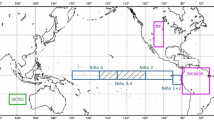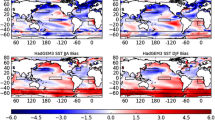In many regions of the globe, the largest climate signals after the seasonal cycle are those associated with El Niño and La Niña. These are manifestations of a coupled process in which climate changes occur in both atmosphere and ocean. The origins of El Niño and La Niña (or ENSO, the El Niño/Southern Oscillation) lie in the tropical Pacific, but the effects can be felt to some degree almost globally. It is in the equatorial region that coupling between atmosphere and ocean is strong. In middle latitudes the coupling is much weaker. Models of varying complexity have been developed to study ENSO. So-called intermediate models, where the atmosphere is grossly simplified and only the upper ocean is modeled, have been used to understand the role of equatorial waves in setting the timescales of ENSO as well as being used for seasonal prediction. Seasonal forecasting using complex models of the atmosphere and ocean is relatively recent. The atmospheric component of such models is very similar to what is used in weather forecasting. This is a much more mature science and there is some synergy between weather and seasonal forecasting. Both are initial value problems in the sense that the information on which a forecast is based depends on these starting conditions. The atmospheric initial state for a seasonal forecast is generally provided from the atmospheric state created to initialize a weather forecast. So seasonal forecasting relies on weather forecasting in that sense. There is a much more important reliance on weather forecasting however, which involves the ocean and atmospheric reanalyses. If there were sufficient observations of the ocean, then it would be possible to create ocean initial conditions just from the observations, but this is not the case. Even with today’s observing system it is still necessary to augment the ocean observations with knowledge of the ocean gleaned from the past history of the ocean forcing (momentum, heat and freshwater fluxes), as will be discussed in. Some results from complex models are presented to allow an assessment of skill and to contrast the predictability of the tropics with the extratropics. The potential importance of using multi models is introduced which allows some assessment of the importance of model error. A developing field is the application of seasonal forecasts. For some applications, only a simple concept is required, but for others quite complex application models are needed. Developing these modules can be difficult as the functional dependence on weather parameters is not always obvious. One example is given but a full assessment of the difficulties in developing application models is left to later chapters (Chapters 11–13).
Access this chapter
Tax calculation will be finalised at checkout
Purchases are for personal use only
Preview
Unable to display preview. Download preview PDF.
Similar content being viewed by others
Author information
Authors and Affiliations
Editor information
Editors and Affiliations
Rights and permissions
Copyright information
© 2008 Springer Science + Business Media B.V
About this paper
Cite this paper
Anderson, D.L.T. (2008). Overview of Seasonal Forecasting. In: Troccoli, A., Harrison, M., Anderson, D.L.T., Mason, S.J. (eds) Seasonal Climate: Forecasting and Managing Risk. NATO Science Series, vol 82. Springer, Dordrecht. https://doi.org/10.1007/978-1-4020-6992-5_3
Download citation
DOI: https://doi.org/10.1007/978-1-4020-6992-5_3
Publisher Name: Springer, Dordrecht
Print ISBN: 978-1-4020-6990-1
Online ISBN: 978-1-4020-6992-5
eBook Packages: Earth and Environmental ScienceEarth and Environmental Science (R0)




